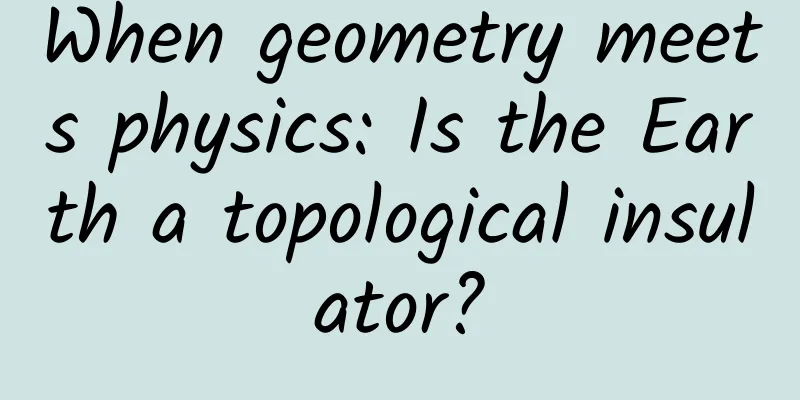When geometry meets physics: Is the Earth a topological insulator?

|
As physics developed into the 20th century, geometry in mathematics was introduced into physical theory. Einstein constructed the theory of general relativity with the help of Riemannian geometry, and Yang Zhenning discovered the correspondence between gauge fields and fiber bundles. The birth of topological quantum field theory in the 1980s pushed physics to a new peak. Geometric theory and related concepts have been so effective in physical theory that many people say "physics is geometry". Today, these physical concepts born from geometry have penetrated into many fields such as atmospheric science and information science, and have also brought new vitality to geometry. Written by Dong Weiyuan Physical theories are often borrowed and used across fields. In recent years, meteorologists have compared the Earth to a topological insulator when studying the laws of ocean and atmospheric waves [1-3]. With the help of the methods and conclusions of physicists in studying topological phase transitions, they have gained a deep understanding of the formation mechanism of equatorial Kelvin waves. Kelvin waves are a type of ocean and atmospheric wave caused by the deflection force of the Earth's rotation (Coriolis force). Its biggest feature is that the group velocity is the same as the phase velocity, so this type of wave will not dissipate in the process of traveling, and can continuously transport energy across thousands of kilometers. It is one of the important factors in the formation of climate phenomena such as El Niño. In fact, this wave was discovered as early as 1879 and named after its discoverer. Yes, the discoverer was the scientific genius Lord Kelvin, and the absolute temperature scale was also named after him. I believe that the old lord would never have thought that the ocean and atmospheric waves he discovered more than 100 years later would be connected to modern physics in such a strange way. Even if the old lord took a time machine to the present, he probably couldn't quickly understand why Kelvin waves are actually a kind of "excitation under topological protection." Modern physics is almost everywhere permeated with geometric concepts and geometric language, the depth and breadth of which are simply unimaginable to 19th century physicists. Differential geometry enters physics The general theory of relativity, which came out in 1915, was the first milestone in the geometrization of physics. From then on, differential geometry became a mathematical language that physicists must master. Since the essence of gravity is the curvature of space-time, and the gravitational field strength is the curvature of space-time, then the study of manifolds is naturally the primary preparatory knowledge for learning general relativity. The so-called manifold can be considered as various graphics. For example, the surface of a potato is a 2-dimensional manifold, while the space-time studied by general relativity is a 4-dimensional manifold. In order to be able to calculate, a coordinate system must be established on the manifold. If the shape of the manifold itself is strange, or the coverage of the coordinate system is limited, and only one coordinate system cannot cover all the points on the manifold, then it is necessary to select multiple points on the manifold, each point can establish a local coordinate system to cover the surrounding neighbors, and then all the local coordinate systems are collaged together to cover the entire manifold. For example, a 4-dimensional Cartesian coordinate system with the Earth at a certain moment as the origin cannot cover the interior of a distant black hole. Even after an infinite amount of time, it can only reach a place very close to the black hole's event horizon. However, this does not mean that space-time itself is torn apart at the event horizon. Astronauts close to the black hole's event horizon can establish a new coordinate system with their own position and a certain moment as the origin. This coordinate system overlaps with our coordinate system and coincides with other coordinate systems inside the black hole. With the support of multiple coordinate systems, a smooth world line can be drawn connecting the Earth and the interior of the black hole, so that it can be seen that space-time itself is still intact at the event horizon. In addition, to discuss curvature, we must first make the manifold fixed and motionless. Obviously, the surface of a squirming jellyfish will not have a definite curvature. The meaning of fixedness is equivalent to "there is a definite distance between any two points on the manifold", so the definition of distance on the manifold must precede the definition of curvature. It is called a "metric", which answers the question of how to calculate the distance between each point on the manifold and its neighboring points. If each point on the manifold has its own metric, then the entire manifold will be "petrified", and only then can the curvature be calculated. There are several mathematical definitions of curvature, and physicists prefer to use Riemann's definition. Riemann curvature can be understood by the changes in a vector during its movement, so before understanding it, we also need to understand how the curvature of the manifold affects the movement of the vector. In a flat space, a vector can be translated at will without changing, but in a curved space, this freedom does not exist. For example, if we move a vector on the sphere shown in the figure above, and also start "translating" from the equator (note that the direction of a vector in a 2-dimensional sphere can only be tangent to the sphere), the direction of the vector that reaches the North Pole after the orange path is different from the direction of the vector that reaches the North Pole after the blue path. This is the effect caused by the curvature of the sphere. Riemann curvature uses this effect to define the curvature of each point on the manifold. The specific method is to let This is obviously a mapping, a mapping from three vectors to one vector. The "machine" that provides this mapping function is called a tensor. Riemann curvature is a tensor, so it is also called the Riemann tensor. By the way, the metric mentioned earlier is also a tensor. In fact, the entire general relativity equation is a tensor equation. Fiber Bundles and Gauge Fields The Yang-Mills theory, which made its debut in 1954, laid the groundwork for the second wave of geometrization of physics. More than a decade later, physicists suddenly discovered that fiber bundles were the most appropriate language to describe this theory. The so-called fiber bundle can be roughly understood as a manifold covered with hair, with each hair corresponding to a point on the bottom manifold. The hair here, that is, the fiber, has a rather abstract connotation, and in different fiber bundle theories, it represents different attachments on the manifold. These attachments can be either natural or acquired. The most intuitive type of fiber is the tangent space of each point on the manifold. As the name suggests, it is the space where all vectors at this point live. The figure on the left below shows a specific example, where the bottom manifold M is a 2-dimensional sphere and the blue plane is the tangent space of point P on M. An abstract painting method of this kind of relationship. When introducing curvature, I mentioned the "translation" of a vector on a manifold vaguely. The concept of tangent bundle is intuitive and easy to understand, but it is not a powerful weapon for physicists. What really makes physicists love it is a fiber bundle that can contain symmetry. Because it is so core and important, it is simply named the principal bundle. When talking about symmetry, we need to distinguish between global symmetry and local symmetry. The former is the symmetry of the entire manifold, while the latter is the property of each point. The following content will show that local symmetry is much more important in physics than global symmetry. The mathematical language used to describe symmetries is groups, and each type of symmetry corresponds to a specific group. For example, the O(n) group and the SO(n) group correspond to rotational symmetries in n-dimensional real space, while the U(n) group and the SU(n) group represent rotational symmetries in n-dimensional complex space. In the 3D space we live in, any rotation operation can be decomposed into a combination of the three basic operations of rotation around the x, y, and z axes. In other words, if the SO(3) group itself is considered as a space, its dimension is also exactly 3. However, the SO(4) group is different. Rotation in 4D space is composed of 6 basic operations[4], so the dimension of the SO(4) group itself is 6, not 4. The group itself can also be viewed as a space, just like the intuitive tangent space, so it can also be viewed as a fiber inserted into the underlying manifold, except that the space represented by each fiber may have a different number of dimensions than the underlying manifold. This fiber bundle with group structure is the principal bundle. The local symmetry represented by the fiber means that when the function Φ(x) on the underlying manifold changes along the fiber, the value of Φ(x) at each point remains unchanged, so different sections on the principal bundle are equivalent to Φ(x). In physics, fields with local symmetry like Φ(x) are collectively called gauge fields. In the eyes of physicists, spacetime itself is a fiber bundle, and various fundamental interactions originate from various gauge fields, that is, the connection of principal bundles carrying different symmetry groups. The gravitational field corresponds to SO(3, 1), the electromagnetic field and weak force correspond to U(1)×SU(2), and the strong force corresponds to SU(3). The latter two are combined, and the main bundle carrying the U(1)×SU(2)×SU(3) structure is a large space in which all interactions in the universe except gravity are beautifully combined into one object. This is the Yang-Mills theory, which is comparable to general relativity and is the most important theoretical cornerstone of the standard model of elementary particles. Support from topological theory Topology is often jokingly called the science of playing with plasticine. It does not care about the specific shape or size of geometric figures, but only focuses on the unchanged components of the figures during continuous changes. A coffee cup can be continuously transformed into a donut, so from a topological perspective, a coffee cup and a donut are the same object because they have the same number of holes. Obviously, the number of holes is a topological invariant. However, when mathematicians say that A and B are the same in a topological sense, they use different terms to express the meaning of "same", the most common of which are isomorphism, homeomorphism, homomorphism, homotopy, homology, etc. From this we can see that topological theory is not as simple as kneading plasticine. In addition, in the tree of mathematics, the position of topology is not a branch with clear boundaries, nor is it limited to the field of geometry, but more like a vine that is entangled everywhere. Because of this, it can often play a unique power of simplifying many problems. There is an interesting theorem called the "hairy ball theorem", which states that a smooth tangent vector field on an even-dimensional sphere must have zeros. The 2D case of this theorem is very intuitive, and it essentially states that you can never completely smooth out a hairy ball, which is why the theorem got its name. In contrast, we can also intuitively see that the tangent vector field on the torus can be non-zero everywhere, which shows that the overall topological properties of the manifold are closely related to the characteristics of the vector field on it. If readers feel that this theorem is not so simple, you might consider the electromagnetic wave emitted by a point source. Its wavefront is a two-dimensional sphere, and electromagnetic waves are transverse waves. The direction of the field intensity is always tangent to the wavefront. According to the hairy ball theorem, there must be a zero point of field intensity on the wavefront[5]. However, every point on the wavefront has the same vibration phase, and it is completely symmetrical to the point source. Do you smell the smell of magic? When electromagnetic waves propagate in certain special media, the hairy ball theorem will also appear in the parameter space. Although the partial differential equations describing the dynamic process are difficult to solve, the topological properties alone can determine that zero points will definitely appear. This special point generated purely by topological properties often corresponds to some kind of "topological excitation". The reason why topological theory can exert its great power is that it relies on establishing a connection between various topological invariants and various integral results in the physical field. As mentioned in the previous part of the article, the field intensity in the physical field corresponds to the curvature in the geometric sense, and the distance relationship corresponds to the metric. If a certain integral result in the physical field is independent of the field intensity and the integral path length, then translated into geometric language, the result is independent of the curvature and metric of the manifold, so even if the manifold wriggles like a jellyfish, the integral result will not change, then this result should only be determined by a certain topological invariant of the manifold. Based on this idea, physicists are very keen to study various integral results, especially those on closed loops or closed surfaces. If a physical quantity that is independent of field strength and path length is indeed discovered, people will excitedly run to the warehouse of topology to look for the relevant topological invariants. Regarding the integration path, smart physicists are certainly unwilling to try them one by one manually, but would like to use research strategies that can be "wholesale". Let's start with a silly question. On a plane, starting from a fixed point, drawing a closed curve and finally returning to the fixed point, how many ways can there be to draw it? The answer is obvious, any two ways of drawing are topologically identical, in technical terms, all paths are homotopic. If a hole is dug in a plane, all the paths are obviously no longer homotopic, because some paths can shrink to a point, while some paths will be blocked by the hole when shrinking and cannot shrink to a point. We found that all paths can be divided into several categories according to the number of circles around the hole, and the paths with the same number of circles around the hole are homotopic. The group can be represented by all integers, where each integer represents a homotopy path with a winding number equal to that integer. Since windings can be clockwise or counterclockwise, the two can cancel each other out, so there naturally exist winding numbers of negative integers. I won’t introduce them in detail, but I will briefly mention the number of holes on the manifold and the winding number in the one-stroke drawing game. These are typical topological invariants. In addition, the classification of knots in knot theory is also a topological invariant. The most intuitive topological invariant is the "Euler characteristic" that has appeared in elementary school mathematics. A 3D convex polyhedron always satisfies V-E+F=2, where V is the number of vertices, E is the number of edges, and F is the number of faces. Because the surfaces of 3D convex polyhedra are all isomorphic to 2D spheres, they all have However, manifolds with the same Euler characteristic number are not necessarily all isomorphic. For example, one-dimensional ring, two-dimensional torus, Möbius strip and Klein bottle have the Euler characteristic number of 0, but they are obviously not homomorphic, and even some basic properties are very different. In addition to the Euler characteristic, there are many other topological invariants. Due to the limitation of space and my own knowledge, I will not list them all. But there is one topological invariant that is very important to modern physics and must be mentioned, that is the Chern-Simons action. As the name suggests, this topological invariant naturally corresponds to a physical product. It is not just an ordinary integral, but the core of generating all the dynamic properties of the entire physical field. I believe many readers are already familiar with the routine of deriving the motion equation from the principle of least action. As for why this topological invariant is so naturally friendly to physics, it is because it was developed by physicists - by Witten, the only physicist who has won the Fields Medal. Of course, the basis of his work comes largely from the previous achievements of Shiing-Shen Chern and others, especially a mathematical object called "Chen-Simons 3-form", so this theory introduced into physics by Witten and others is still called "Chen-Simons theory". It is with this as the core that Witten, Schwartz and others have opened up a new branch of quantum field theory - topological quantum field theory (TQFT). In a sense, the emergence of topological quantum field theory has further strengthened the geometric color of modern physics. summary In the development process of recent decades, modern physics and modern geometry theory have not only complemented each other and grown together, but also developed many more versatile theoretical tools together, which are widely used in information science, economics, social science and other fields. The meteorological research results mentioned at the beginning of the article are the contributions made by topological quantum field theory to this field. Yang Zhenning once said to Shiing-Shen Chern: "The conceptual consistency of the non-commutative gauge field and the wonderful theory of fiber bundles is a miracle to me. Especially since mathematicians did not refer to the physical world when they discovered it. You mathematicians imagined it out of thin air." Shiing-Shen Chern immediately denied it: "No, no, these concepts are not imagined out of thin air, they are natural and real!" References and Notes [1] Delplace, P., Marston, JB, & Venaille, A. (2017). Topological origin of equatorial waves. Science, 358(6366), 1075–1077. https://doi.org/10.1126/science.aan8819 [2] Tong, D. (2022). "A Gauge Theory for Shallow Water". arXiv:2209.10574. [3] McCormick, Katie (July 18, 2023). "How Quantum Physicists Explained Earth's Oscillating Weather Patterns". Quanta Magazine. [4] The axis of rotation in four-dimensional space is a plane rather than a line. The four coordinate axes are combined in pairs, and there are a total of six basic axis planes. [5] Bormashenko, Edward (2016-05-23). "Obstructions imposed by the Poincaré–Brouwer ("hairy ball") theorem on the propagation of electromagnetic waves". Journal of Electromagnetic Waves and Applications. 30 (8): 1049–1053. Bibcode:2016JEWA...30.1049B. doi:10.1080/09205071.2016.1169226. ISSN 0920-5071. S2CID 124221302 This article is supported by the Science Popularization China Starry Sky Project Produced by: China Association for Science and Technology Department of Science Popularization Producer: China Science and Technology Press Co., Ltd., Beijing Zhongke Xinghe Culture Media Co., Ltd. Special Tips 1. Go to the "Featured Column" at the bottom of the menu of the "Fanpu" WeChat public account to read a series of popular science articles on different topics. 2. Fanpu provides a function to search articles by month. Follow the official account and reply with the four-digit year + month, such as "1903", to get the article index for March 2019, and so on. Copyright statement: Personal forwarding is welcome. Any form of media or organization is not allowed to reprint or excerpt without authorization. For reprint authorization, please contact the backstage of the "Fanpu" WeChat public account. |
<<: My clothes have white spots after washing. What else can I do except buy another one?
>>: These "dwarfs" of the plant kingdom are actually the earliest "pioneers" to land on Earth
Recommend
When cleaning before the end of the year, be careful not to use the wrong disinfectant, which may cause a "big accident"!
Expert of this article: Chu Yuhao, PhD of Beijing...
83.2 meters! The tallest in China! Can trees achieve "immortality"?
recently Two records for trees were broken First,...
Just because you have a 4K TV doesn't mean you can watch the World Cup in 4K
The World Cup is in full swing. This highly antic...
The trillion-dollar business of live streaming sales!
Amidst the attention of the entire nation and the...
If we don’t have a lot of money, how can we do marketing promotion efficiently?
Some thoughts before reading: "Half of my ad...
2015 Smart Travel Hardware Research Report
[[157433]] Produced by Xiaofanzhuo FA team Li Yiq...
The universe is huge. Are there creatures that are hundreds of millions times larger than humans?
Living things are the most wonderful and interest...
What to do if adverse reactions occur? A complete guide to children's vaccinations, recommended to save!
Today is National Children's Vaccination Awar...
Analysis of Pinduoduo’s “Shake for Cash” campaign operations!
Have you participated in Pinduoduo’s “Shake for C...
How to produce popular content? You need to know these 4 points!
The author of this article analyzes four aspects:...
How did Meilishuo attract its first 1 million users?
Meilishuo was founded in 2009 and now has nearly 1...
Do you know what features App development can really improve customer retention rate?
[[148029]] Original English text: The Next Featur...
B station user operation strategy analysis report!
This article takes Bilibili as the analysis objec...
Where will the next main battlefield be for video websites under attack from both inside and outside?
From corporate mergers and acquisitions, copyrigh...









